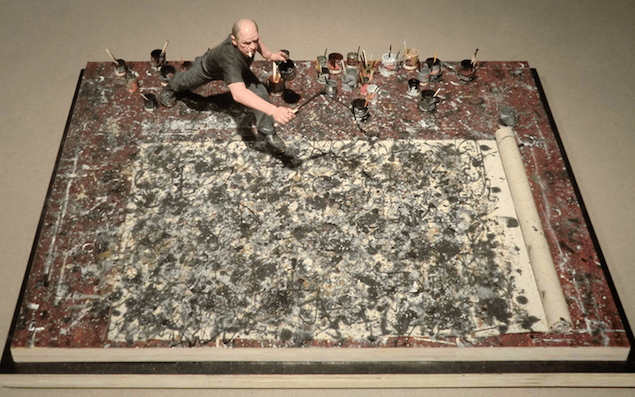Often, when people think of Abstract Expressionism, images of Jackson Pollock’s action painting or Mark Rothko’s large scale colour field canvases come to mind. And indeed, these two figures, along with the likes of Willem de Kooning, Joan Mitchell and Clyfford, pioneered this revolutionary art movement. However, Abstract Expressionism is not limited to that time period, and has continuously evolved over the last 70 years, still as popular as ever to artists and collectors alike.

Jackson Pollock working on one of his iconic drip paintings (courtesy of ArtWizard).
Today, Abstract Expressionism triumphs as one of the most sought-after styles of art. Here are some of the top contemporary Abstract Expressionist artists, showcasing a range of paintings, collages, digital works and drawings.
Andrew Crane
Self-taught artist Andrew Crane works in a style that is broad yet immediately recognisable. There is a distinct poetry to his arrangements, as Andrew composes his canvases as harmonious and intriguing arrangements of colour, material and shape. Whilst some paintings such as Hill and Spanish Blue resemble landscapes, works like One up Two down and Rinsed with silence clearly demonstrate Andrew’s exploration of colour and composition.
Spanish Blue, 2019, by Andrew Crane
Some of Andrew’s paintings include letters, some include words, and some include shapes that allude to familiar objects. It is in this balance between the familiar and the abstract that Andrew’s style echoes that of Abstract Expressionist Helen Frankenthaler. Both diverse in style and considerate of shape, these artists demonstrate how the intuitive nature of Abstract Expressionism can result in works of art that are simultaneously poetic and spontaneous.
HILL, 2020, by Andrew Crane
Angelika Millmaker
Angelika Millmaker was born in Norway, with the country’s rural countryside inspiring many of her paintings. The appearance of the natural landscape in summer is particularly influential to Angelika’s style, as many of her paintings capture effects of light on long summer days, or wonder of the midnight sun.
The Garden Party in Blue III, 2020, by Angelika Millmaker
There is a delicacy to Angelika’s paintings which, together with the rich textures of her paintings, makes for atmospheric observations of the natural world. Many of Angelika’s works are limited to few colours, making her use of space compelling. Red is most commonly used throughout her work, and in pieces such as Aurora III and The Pink Hour, Angelika’s style resembles that of late Abstract Expressionist artist Cy Twombly.
Jane Pryor
Jane Pryor is most commonly known for her colour field paintings and collages. Since graduating from Central St Martins in 2002, Jane has continuously developed her style, particularly her attention to composition and her use of colour.
you make my heart sing 2, 2020, by Jane Pryor
Jane’s collages you make my heart sing 2 and I’ve been smiling lately reveal her knack for colour and shape, and the relationship between the two. Although small in scale, these pieces merge and match different colours, styles and shapes to form simple yet layered pieces. Jane is particularly interested in the ‘space between’, whether that be the space between shapes, colour or layers. Thus the relationship between the components of Jane’s paintings captures the artist’s interest with the space that exists between thinking, looking and remembering.
Paul Coghlin
Paul Coghlin does not strictly focus on abstract expressionism; in fact a great number of his works are quite the opposite and focus on depicting realism. His photography captures his subject so completely, exhibiting every shadow, every line and every mark faultlessly. However, his digital works depart from photography, and venture into the abstract.
Untitled #01, 2020, by Paul Coghlin
Paul’s untitled series takes on the marbling of shape and colour. The consistency of aquatic colours and tones makes each piece resemble liquid surfaces, with Untitled #1 even suggesting a reflection from above. Paul’s digital Abstract Expressionist works are entirely unique to his style and to the rest of our collection.
Luca Grechi
Rome-based artist Luca Grechi has a deep interest in drawing and the landscape. His drawings demonstrate his observations of nature and their inherent journeys of transformation. Most of Luca’s drawings are done with a vivid blue ink that evokes Yves Klein’s International Klein Blue.
No title, 2020, by Luca Grechi
However, unlike Klein, Luca’s mark-making is more obviously shaped. Whether appearing as a cloud of blue or as the elegant stem of a plant, Luca’s use of just one colour produces work that could resemble an abstract poured piece, a screen-print, or an expressive drawing. The vivid nature of Luca’s work, paired with the unexpected and intriguing depiction of form, makes for a slightly more restrained example of the Abstract Expressionist style.






